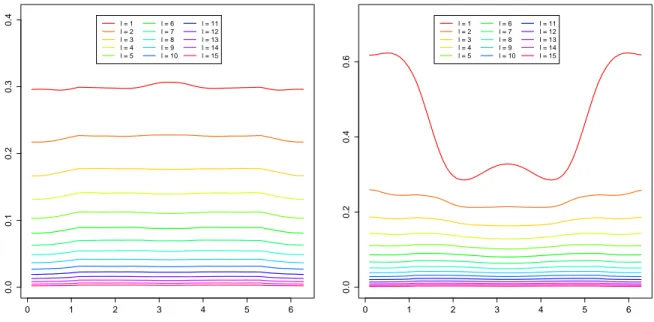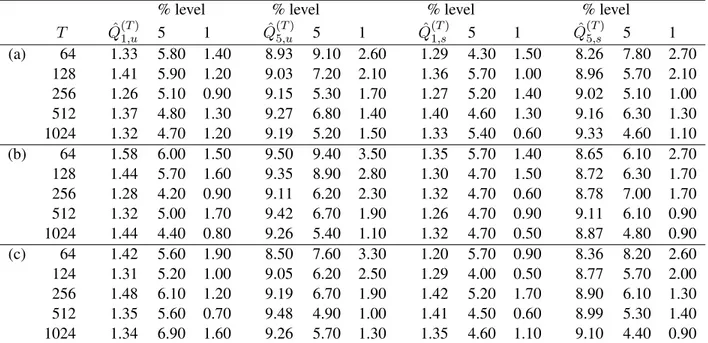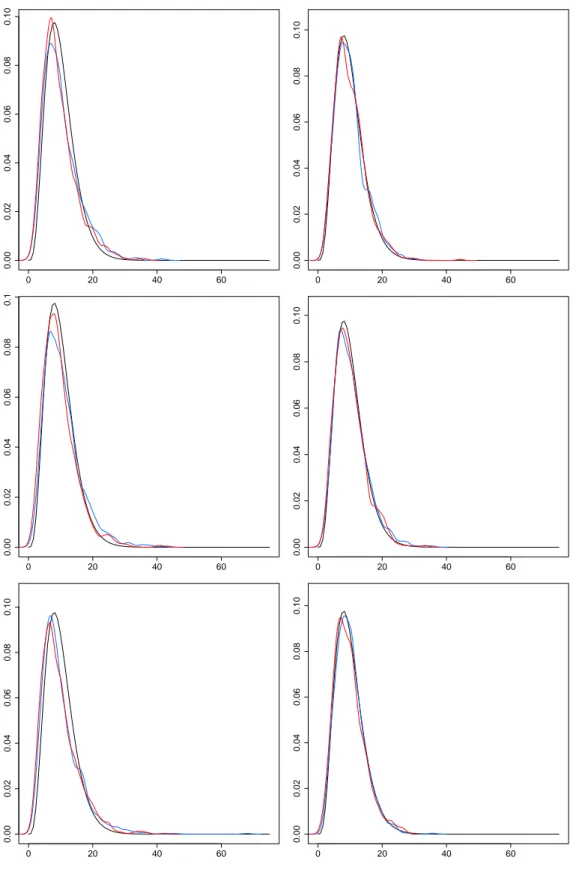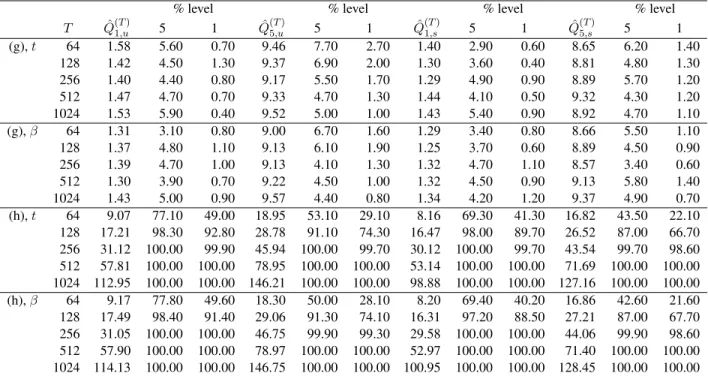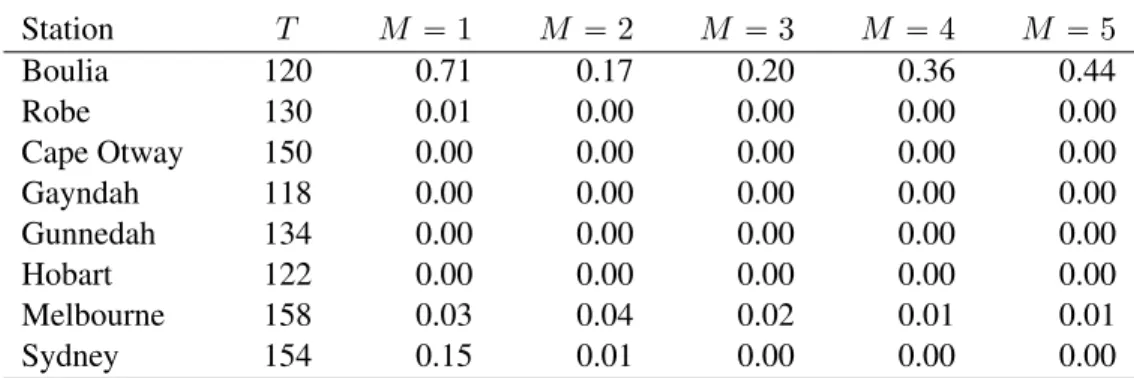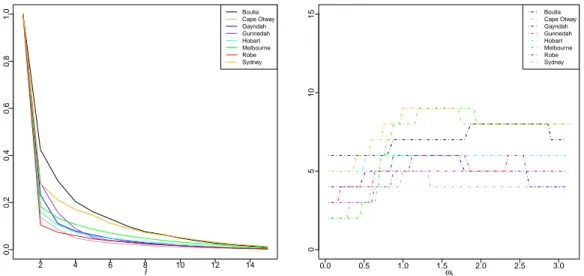SFB 823
Testing for stationarity of
functional time series in the frequency domain
Discussion Paper Alexander Aue, Anne van Delft
Nr. 19/2019
Testing for stationarity of functional time series in the frequency domain
∗Alexander Aue† Anne van Delft‡ May 1, 2019
Abstract
Interest in functional time series has spiked in the recent past with papers covering both methodology and applications being published at a much increased pace. This article contributes to the research in this area by proposing a new stationarity test for functional time series based on frequency domain methods.
The proposed test statistics is based on joint dimension reduction via functional principal components analysis across the spectral density operators at all Fourier frequencies, explicitly allowing for frequency- dependent levels of truncation to adapt to the dynamics of the underlying functional time series. The properties of the test are derived both under the null hypothesis of stationary functional time series and under the smooth alternative of locally stationary functional time series. The methodology is theoretically justified through asymptotic results. Evidence from simulation studies and an application to annual tem- perature curves suggests that the test works well in finite samples.
Keywords: Frequency domain methods, Functional data analysis, Locally stationary processes, Spectral analysis
MSC 2010:Primary: 62G99, 62H99, Secondary: 62M10, 62M15, 91B84
1 Introduction
The aim of this paper is to provide a new stationarity test for functional time series based on frequency domain methods. Particular attention is given to taking into account alternatives allowing for smooth variation as a source of non-stationarity, even though non-smooth alternatives are covered within the simulation study.
Functional data analysis has seen an upsurge in research contributions for at least one decade. This is reflected in the growing number of monographs in the area. Readers interested in the current state of statistical inference procedures may consult Bosq (2000), Ferraty & Vieu (2010), Horv´ath & Kokoszka (2012), Hsing & Eubank (2015) and Ramsay & Silverman (2005).
∗AA was partially supported by NSF grants DMS 1305858 and DMS 1407530. AvD was partially supported by Maastricht University, the contract “Projet d’Actions de Recherche Concert´ees” No. 12/17-045 of the “Communaut´e franc¸aise de Belgique” and by the Collaborative Research Center “Statistical modeling of nonlinear dynamic processes” (SFB 823, Project A1, C1, A7) of the German Research Foundation (DFG).
†Department of Statistics, University of California, Davis, CA 95616, USA, email:aaue@ucdavis.edu
‡Ruhr-Universit¨at Bochum, Fakult¨at f¨ur Mathematik, 44780 Bochum, Germany, email:Anne.vanDelft@rub.de
arXiv:1701.01741v3 [stat.ME] 29 Apr 2019
Papers on functional time series have come into the focus more recently and constitute now an active area of research. H¨ormann & Kokoszka (2010) introduced a general weak dependence concept for stationary func- tional time series, while van Delft & Eichler (2018a) provided a framework for locally stationary functional time series. Antoniadis & Sapatinas (2003), Aue et al. (2015) and Besse et al. (2000) constructed prediction methodology that may find application across many areas of science, economics and finance. With the ex- ception of van Delft & Eichler (2018a), the above contributions are concerned with procedures in the time domain. Complementing methodology in the frequency domain has been developed in parallel. One should mention Panaretos & Tavakoli (2013), who provided results concerning the Fourier analysis of time series in function spaces, and H¨ormann et al. (2015), who addressed the problem of dimension reduction for functional time series using dynamic principal components.
The methodology proposed in this paper provides a new frequency domain inference procedure for func- tional time series. More precisely, tests for second-order stationarity are developed. In the univariate case, such tests have a long history, going back at least to the seminal paper Priestley & Subba Rao (1969), who based their method on the evaluation of evolutionary spectra of a given time series. Other contributions build- ing on this work include von Sachs & Neumann (2000), who used local periodograms and wavelet analysis, and Paparoditis (2009), whose test is based on comparing a local estimate of the spectral density to a global estimate. Dette et al. (2011) and Preuß et al. (2013) developed methods to derive both a measure of and a test for stationarity in locally stationary time series, the latter authors basing their method on empirical process theory. In all papers, interest is in smoothly varying alternatives. The same tests, however, also tend to have power against non-smooth alternatives such as structural breaks or change-points. A recent review discussing methodology for structural breaks in time series is Aue & Horv´ath (2013), while Aue et al. (2018) is a recent contribution to structural breaks in functional time series.
The proposed test for second-order stationarity of functional time series seeks to exploit that the Discrete Fourier Transform (DFT) of a functional time series evaluated at distinct Fourier frequencies are asymptot- ically uncorrelated if and only if the series is second-order stationary. The proposed method is therefore related to the initial work of Dwivedi & Subba Rao (2011), who put forth similar tests in a univariate frame- work. Their method has since been generalized to multivariate time series in Jentsch & Subba Rao (2015) as well as to spatial and spatio-temporal data by Bandyopadhyay & Subba Rao (2017) and Bandyopadhyay et al.
(2017), respectively. A different version of functional stationarity tests, based on time domain methodology involving cumulative sum statistics (Aue & Horv´ath, 2013), was given in Horv´ath et al. (2014).
The intrinsic variation of a functional time series is always larger than any sample size, and standard results known from univariate and multivariate time series analysis do not directly apply. From a practical perspective this brings to the fore the question of how to compress this infinite-dimensional variation to finite dimension in a meaningful way, as there is a complex interplay between dynamics occurring across frequencies and the function space. This means that dimension reduction has to be done jointly across estimated spectral density operators at all Fourier frequencies, yet separately as the exact level of dimension reduction has to be decided
per frequency. The proposed test statistics collect these different sets of projections, obtained via functional principal components analysis, into a quadratic form encapsulating the second-order dynamics. To derive the large-sample behavior of this statistic under both the null hypothesis of a stationary time series and the alterna- tive of a locally stationary functional time series requires new, and perhaps independently interesting, results on distributional convergence of a cross-periodogram operator in function space, where verifying existence of the limit process and tightness are nontrivial tasks. The subsequent proofs of distributional convergence of the test statistics which require taking into account the pecularities of fPCA estimators, are also complex and new.
The main results are derived under the assumption that the curves are observed in their entirety, corresponding to a setting in which functions are sampled on a dense grid rather than a sparse grid. Differences for these two cases have been worked out in Li & Hsing (2010).
The remainder of the paper is organized as follows. Section 2 provides background, gives requisite nota- tions, introduces properties of functional version of the DFT and gives intuition for the test. The exact form of the hypothesis test, model assumptions and the test statistics are introduced in Section 3. The large-sample behavior under the null hypothesis of second-order stationarity and the alternative of local stationarity is es- tablished in Sections 4. Empirical aspects are highlighted in Section 5. The proofs are technical and relegated to the Appendix. Several further auxiliary results are proved in the supplementary document Aue & van Delft (2019), henceforth referred to simply as the Online Supplement.
2 Notation and setup
A functional time seriespXt:tPZqwill be viewed as a sequence of random elements on a probability space pΩ,A, Pq with paths in a separable Hilbert space. Without loss of generality, we shall focus on processes taking values inHR“L2Rpr0,1sq, the space of equivalence classes of real-valued, square integrable functions on the unit intervalr0,1s. Because the methodology introduced in this paper is based on a frequency domain approach, we shall make extensive use of the complex Hilbert spaceH “ L2
Cpr0,1sq. We briefly introduce notation and relevant properties of this space and associated operators. The complex conjugate ofz P Cis denoted byzand the imaginary number byi. Forf, gPH, the inner product and the inducedL2-norm onH are respectively given by
xf, gy “ ż1
0
fpτqgpτqdτ and }f}2 “a
xf, fy. (2.1)
Two elements of H are understood to be equal if their difference has vanishingL2-norm. More generally, for measurable functionsg: r0,1sk Ñ C, theLp-norm shall be denoted by}g}p and the supremum norm by }g}8“supτPr0,1sk|gpτq|.
Next, some properties of linear operators onHare stated. Denote byS8pHqthe Banach space of bounded linear operatorsA:H Ñ H equipped with the operator norm~A~8 “sup}g}2ď1}Ag}2. For allf, g PH, the adjoint operator ofA, denoted byA:, is defined byxAf, gy “ xf, A:gyand the conjugate operator ofA
is given byAg “ pAgq. An operatorAis called self-adjoint ifxAf, gy “ xf, Agyfor allf, g P Hand non- negative definite ifxAg, gy ě0for allgPH. ForvPH, define the tensor productfbg:HbH ÑHas the bounded linear operatorpfbgqv“ xv, gyf. A compact operatorAadmits asingular value decomposition
A“
8
ÿ
n“1
snpAqψnbφn, (2.2)
where psnpAq: n P Nq, are the singular values ofA, pφn: n P Nq and pψn: n P Nq orthonormal bases ofH. The singular values are ordered to form a monotonically decreasing sequence of non-negative num- bers. A compact operator A is said to belong to the Schatten p-class SppHq if and only if the sequence spAq “ psnpAq: n P Nq of singular values of A belongs to the sequence space `p, so if and only if
~A~p “ př8
n“1spnpAqq1{p ă 8, where ~A~p is referred to as the Schatten p-norm. Relevant here are S1pHq, the space of trace-class operators, and particularlyS2pHq, the space of Hilbert–Schmidt operators.
The latter is also a Hilbert space with inner product xA, ByS “ ř8
i“1xAψi, Bψiy where A, B P S2pHq andpψn: n P Nqis an ONB of H. The mappingT: HbH Ñ S2pHq defined by the linear extension of Tpfbgq “fbgis an isometric isomorphism and defines a Hilbert–Schmidt operator with kernel inHˆH given bypf bgqpτ, σq “ fpτqgpσq,τ, σ P r0,1s. As a consequence,A P S2pHqif and only if there exists aPHˆH such that~A~2 “ }a}2. Further useful properties needed in the proofs of the various statements of this paper are relegated to the Appendix and the Online Supplement.
2.1 Dependence structure on the function space Let L2
CpΩq be the Hilbert space with elements satisfiying Er}X}22s ă 8 and denote by ErXs the mean function ofX, where the expectation should be viewed in the sense of a Bochner integral. ForX, Y PL2
CpΩq, the covariance operator CX,Y: H bH Ñ H is defined as CX,Y “ ErpX ´ErXsq b pY ´ErYsqs and belongs toS2pHq. A functional time seriesX “ pXt:tPZqis called strictly stationary if, for all finite sets of indicesJ Ă Z, the joint distribution ofpXt`j:j PJqdoes not depend ontP Z. Similarly,X is weakly stationary if its first- and second-order moments exist and are invariant under translation in time. Without loss of generality, it is assumed throughout thatErXts “ 0and that Xt P L2RpΩq for allt P Z. The lag-h covariance operator betweenXtandXt`his denoted by
Ct,h“ErXt`hbXts
which reduces to Ch “ ErXh bX0sin case of weak stationarity. Note that this object is a non-negative definite element ofS1pHRqforh“0. The covariance operatorChcan be shown to form a Fourier pair with a non-negative Hermitian element ofSppHq. Provided sufficiently fast decay of the second-order structure, the spectral density operatorFωis well-defined and given by the Fourier transform ofCh,
Fω “ 1 2π
ÿ
hPZ
Che´iωh. (2.3)
A sufficient condition for the existence ofFωinSppHqisř
hPZ~Ch~pă 8.
Higher-order dependence among the functional observations is defined through cumulant mixing condi- tions (Brillinger, 1981; Brillinger & Rosenblatt, 1967). For this, the notion of higher-order cumulant tensors is required; see Appendix B for their definition and a discussion of their properties for nonstationary functional time series.
2.2 The functional discrete Fourier transform
The starting point of this paper is the following proposition that characterizes second-order stationary behavior of a functional time series in terms of a spectral representation. Its proof is in Appendix A.
Proposition 2.1. A zero-mean, H-valued stochastic process pXt: t P Zq whose spectral measure is trace class admits the representation
Xt“ żπ
´π
eitωdZω a.s., (2.4)
wherepZω:ω P p´π, πsqis a right-continuous functional orthogonal-increment process, if and only if it is weakly stationary.
If the process is not weakly stationary, then a representation in the frequency domain is not necessar- ily well-defined and certainly not with respect to complex exponential basis functions. However, a time- dependent functional Cram´er representation exists if the characteristics of the process are captured by a Bochner-measurable mapping that is an evolutionary operator-valued mapping in time direction (van Delft
& Eichler, 2018a). Assume that the functions X1, . . . , XT have been observed. If the process is weakly stationary, thefunctional Discrete Fourier Transform(fDFT) evaluated at frequencyω, given by
DωpTq“ 1
?2πT
T
ÿ
t“1
Xte´iωt, (2.5)
can be seen as an estimate of the increment processZω and exists almost surely as an element ofH. The functional time series itself can then be represented through the inverse fDFT as
Xt“ c2π
T
T
ÿ
j“1
DpTωjqeiωjt. (2.6)
Under regularity conditions, a set of fDFTs evaluated at distinct frequencies yield asymptotically independent Gaussian random elements inH and, for fixedω, one hasVarpDpTω qq Ñ Fω (Panaretos & Tavakoli, 2013).
The fDFT sequence of a Hilbertian-valued stationary process is in particular asymptotically uncorrelated at the canonical frequenciesωj “2πj{T. Consequently, provided the series is weakly stationary, forj ‰j1 or j ‰T ´j1, we have~CovpDωpTjq, DωpTj1qq~2 “Op1{Tq. In other words, the lag-hcovariance operator of the fDFT converges in norm and hence weak operator topology to the zero operator asT Ñ 8. Similar to the above, the reverse argument (uncorrelatedness of the functional DFT sequence implies weak stationarity) can
be shown by means of the inverse fDFT. Using expression (2.5), the covariance operatorCt,hofXt`handXt can be written in terms of the fDFT sequence as
Ct,h “ 2π T
T
ÿ
j,j1“1
ErDpTωjqbDωpTq
j1seiωjh “ 2π T
T
ÿ
j“1
ErDωpTjqbDωpTjqseiωjh “Ch,
where the equality holds in anL2-sense. This demonstrates that the autocovariance kernel of a second-order stationary functional time series is obtained and, hence, that an uncorrelated fDFT sequence implies second- order stationarity up to lagT´1. The fDFT thus captures exactly the defining property of a weakly stationary process and provides a natural starting point for a test of stationarity. It is, however, a nontrivial task to construct a test statistic that optimally extracts the information contained in the infinite-dimensional process to finite dimensions. Not only can the dependence structure and the resulting dynamics of a functional time series be of a complicated nature (see Figure 5.1 and the example given in Section S8 of the Online Supplement), but the process will vary along both frequency and functional directions. To construct a powerful test it is therefore crucial to understand how the fDFT’s behave when weak stationarity is violated. In accordance with aforementioned time series literature, the theoretical behavior of the fDFT sequence under smooth alternatives is studied. These properties will then be exploited to verify large-sample results for a testing framework for functional stationarity.
3 The functional stationarity testing framework
This section gives precise formulations of the hypotheses of interest, states the main assumptions of the paper and introduces the test statistics. Throughout, interest is in testing the null hypothesis
H0:pXt:tPZqis a weakly stationary functional time series versus the alternative
HA:pXt:tPZqis a locally stationary functional time series, where locally stationary functional time series are defined as follows.
Definition 3.1. A stochastic processpXt:tPZqtaking values inHRis said to be locally stationary if (1) Xt“XtpTqfort“1, . . . , T andT PN; and
(2) for any rescaled timeuP r0,1s, there is a strictly stationary processpXtpuq:tPZqsuch that
›
›XtpTq´Xtpuq›
›2ď
´ˇ ˇ ˇ
t T ´u
ˇ ˇ ˇ`T1
¯
Pt,Tpuq a.s.,
wherePt,Tpuqis a positive, real-valued triangular array of random variables such that, for someρ ą0, Er|Pt,Tpuq|ρs ă 8for alltandT, uniformly inuP r0,1s.
Note that, underHA, the process constitutes a triangular array of functions. Inference methods are then based on in-fill asymptotics as popularized in Dahlhaus (1997) for univariate time series. The process is then considered to be observed on a finer grid asT increases such that more observations are available at a local level. A rigorous statistical framework for locally stationary functional time series was recently provided in van Delft & Eichler (2018a). Note that weakly stationary processes are included in Definition 3.1, which then reduces to standard asymptotics.
Based on the observations in Section 2.2, a test for weak stationarity can be set up exploiting the uncor- relatedness of the elements in the sequencepDωpTjq:j “1, . . . , Tq. This could be done considering the lag-h sample covariance operatorT´1řT
j“1DωpTjqbDωpTj`hq which should be centered at the zero operator inS2for allh “ 1, . . . , T ´1. Here, two statistics based on the coefficients in the Karhunen–Lo`eve decomposition of the fDFTs are considered. For j “ 1, . . . , T, letpφωlj: l P Nq be the orthonormal basis of eigenfunc- tions of Fωj and observe that for this choice of basis VarpxDωj, φωljyq “ xFωjpφωljq, φωljy “ λωlj, where pλωlj:l PNq PR`are the eigenvalues ofFωj. Then, for anyj, j1,pφωlj bφωl1j1:l, l1 PNqis an orthonormal basis ofL2Cpr0,1s2qand, by definition of the Hilbert–Schmidt inner product on the algebraic tensor product spaceHbH,
1 T
T
ÿ
j“1
DpTωjqbDωpTj`hq “ 1 T
T
ÿ
j“1 8
ÿ
l“1 8
ÿ
l1“1
@DωpTjqbDωpTj`hq , φωlj bφωl1j`h
D
Sφωlj bφωl1j`h (3.1)
« 1 T
T
ÿ
j“1 L
ÿ
l“1 L1
ÿ
l1“1
xDpTωjq, φωljyxDpTωj`hq , φωl1j`hyφωljbφωl1j`h
for sufficiently largeLandL1. The foregoing motivates to set up tests based on the score products
γj,hpTqpl, l1q “ xDωpTjq, φωljyxDωpTj`hq , φωl1j`hy (3.2) or on the standardized score products
ρpTj,hqpl, l1q “
γj,hpTqpl, l1q b
λωljλωl1j`h
. (3.3)
In practice, the unknown spectral density operatorsFωj andFωj`h are to be replaced with consistent estima- torsFˆωpTjqandFˆpTωj`hq , which will then yield respective sample eigenvaluesλˆωlj and eigenfunctionsφˆωlj. The estimated quantities corresponding to (3.2) and (3.3) will be denoted byˆγj,hpTqpl, l1qandρˆpTj,hqpl, l1q, respectively.
As an estimator ofFω, take
FˆωpTq“ 2π T
T
ÿ
j“1
Kbpω´ωjq`
DpTωjqbDpTωjq˘
, (3.4)
whereKbp¨qis a kernel with bandwidthbsatisfying the following conditions.
Assumption 3.1. (a) LetK:r´12,12s ÑR`be symmetric withş
Kpxqdx“1andş
Kpxq2dxă 8.
(b) Letb“bT be a bandwidth such thatT´1{2 !bT !T´1{4.
(c) LetKbpxq “b´1Kpp2πbq´1xqand and extend the kernel periodically such thatKbpxq “Kbpx˘2πq in order to include estimates for frequencies around˘π.
To set up the test statistics, it now appears reasonable to extract information across a range of directions l “ 1, . . . , Lj andl1 “ 1, . . . , Lj`h as well as a selection of lagsh “ 1, . . . ,¯h, where ¯hdenotes an upper limit. The truncation parameters Lj “ Lpωjq and Lj`h “ Lpωj`hq are explicitly allowed to depend on thej-th andpj`hq-th Fourier frequencies in order to accommodate heterogeneity in the Karhunen–Lo`eve decompositions across the spectral domain. Set
βˆpTh,uq“ 1 T
T
ÿ
j“1 Lj
ÿ
l“1 Lj`h
ÿ
l1“1
ˆ
γj,hpTqpl, l1q and βˆh,spTq“ 1 T
T
ÿ
j“1 Lj
ÿ
l“1 Lj`h
ÿ
l1“1
ˆ
ρpTj,hqpl, l1q, (3.5) where the subscriptsuandsrefer to the un-standardized and standardized forms, respectively. In the follow- ing, the subscriptxwill be used to refer to any of these two versions when no confusion can arise.
Choose next a collection h1, . . . , hM of lags each of which is upper bounded by ¯h to pool information across a number of autocovariances and build the vectors
ˆbpTM,xq “`
<βˆhpTq
1,x, . . . ,<βˆpTh q
M,x,=βˆhpTq
1,x, . . . ,=βˆhpTq
M,x
˘J
,
where<and=denote real and imaginary part, respectively. Finally, set up the quadratic forms
QˆpTM,xq “TpˆbpTM,xqqJΣˆ´1M,xˆbpTM,xq, (3.6) where ΣˆM,x is an estimator of the asymptotic covariance matrix of the vectors bpTM,xq which are defined by replacingγˆj,hpTqpl, l1qandρˆpTj,hqpl, l1qwithγj,hpTqpl, l1qandρpTj,hqpl, l1qin (3.5) and then using the resultingβh,xpTq in place ofβˆh,xpTq in the definition of ˆbpTM,xq. The foregoing provides the two test statisticsQˆpTM,uq andQˆpTM,sq that will be used to test the null of stationarity against the alternative of local stationarity. Note that both quadratic forms depend on the tuning parametersLj,Lj`handM, the selection of which will be evaluated empirically in Section 5.
To facilitate the derivation of large-sample results, the following assumptions are made: for the un- standardized respectively standardized test require
ConditionCu: LetLj „logT andlimlinfωλωl ą0;
ConditionCs: LetinfωλωL¯ ą0for someL¯ ěsupjLj.
In keeping with the above arrangement, the respective conditions will be referred to as Cx if no confusion arises. Condition Cu for the un-standardized test allows to send the truncation levels Lj to infinity in a coordinated manner as long as the divergence is slow (here, logarithmic) compared toT; see Fremdt et al.
(2014). ConditionCs for the standardized test on the other hand requires a finite truncation level, to ensure that the smallest eigenvalues of the compact operatorsFωj are bounded away from zero as these show up in the denominator of (3.3).
4 Large-sample results
4.1 Assumptions
The following gives the main requirements under both stationarity and local stationarity in terms of cumulant tensors of the functional time series (Appendix B) that are needed to establish the asymptotic behavior of the test statistics under both hypotheses. Note that the null hypothesis is nested within the alternative. Because of this basic fact, we start with the general assumptions under local stationarity before specializing to the stationary case.
Assumption I (k,`). AssumepXtpTq:t ď T, T P Nq andpXtpuq:t P Zq are as in Definition 3.1. Suppose suptEr}Xt}minpk,12q2 s ă 8and that there exists a a positive sequenceκk;t1,...,tk´1 inL2
Rpr0,1skq, independent of T such that, for allj“1, . . . , k´1and some`PN,
ÿ
t1,...,tk´1PZ
p1` |tj|`q}κk;t1,...,tk´1}2ă 8. (4.1)
Suppose furthermore that there exist representations
XtpTq´Xtpt{Tq“YtpTq and Xtpuq´Xtpvq“ pu´vqYtpu,vq, (4.2) for some processespYtpTq:t ď T, T P NqandpYtpu,vq:t P Zq taking values inHRwhosek-th order joint cumulants satisfy
(i) }cumpXtpTq
1 , . . . , XtpTq
k´1, YtpTq
k q}2 ď T1}κk;t1´tk,...,tk´1´tk}2, (ii) }cumpXtpu11q, . . . , Xtpuk´1k´1q, Ytpuk k,vqq}2ď }κk;t1´tk,...,tk´1´tk}2, (iii) supu}cumpXtpuq
1 , . . . , Xtpuq
k´1, Xtpuq
k q}2ď }κk;t1´tk,...,tk´1´tk}2, (iv) supu}BuB``cumpXtpuq1 , . . . , Xtpuqk´1, Xtpuqk q}2ď }κk;t1´tk,...,tk´1´tk}2.
Assumption I provides Lipschitz conditions that are generalizations of those in Lee & Subba Rao (2016), who investigated the properties of quadratic forms of stochastic processes in a finite-dimensional setting. The above conditions enable to express the behavior of the fDFT’s of a k-th order locally stationary process in terms ofk-th order time-varying spectral density tensors (Lemma B.1). This is convenient in order to derive explicit expressions of the distributional properties under the alternative and to understand departures from stationarity. Under HA, we can uniquely characterize the second-order stucture of the stochastic process pXtpTq:tďT, T PNqvia thetime-varying spectral density operator
Fu,ω“ 1 2π
ÿ
hPZ
Cu,he´iωh, (4.3)
whereCu,h “cumpXhpuq, X0puqqdenotes the local cumulant tensor at fixed timeuof the stationary approximat- ing processpXtpuq:tPZq. Note that the parameter`and (iii)-(iv) in Assumption I, influence the smoothness of the operator-valued mappingpu, ωq ÞÑ Fu,ω. Under Assumption I(2,2), derivative maps are well-defined
elements ofS2pHqandω ÞÑ Fu;ω is uniformly continuous inω with respect to~¨~2. We refer to Lemma S2.2 for details. More generally, underk-th order local stationarity, these properties carry over to the local k-th order cumulant spectral density tensor
Fu;ω1,...,ωk´1 “ 1 p2πqk´1
ÿ
t1,...,tk´1PZ
Cu;t1,...,tk´1e´i
řk´1
j“1ωjtj, (4.4)
whereω1, . . . , ωk´1 P p´π, πsandCu;t1,...,tk´1 “ cum`
Xtpuq1 , . . . , Xtpuq
k´1, Xtpuq0 ˘
is the corresponding local cumulant kernel tensor of orderkat timeu0. Observe that, forką 1, (4.4) can be viewed as an element of S2pHbtpk`1q{2u, Hbtk{2uq. Underk-th order stationarity the above objects become independent of local timeu, so thatFu;ω1,...,ωk´1 ”Fω1,...,ωk´1, and Assumption I specializes to the following.
Assumption I* (k,`). LetpXt: t P Zq be ak-th order stationary functional time series with values inHR such that (i)Er}X0}minpk,12q2 s ă 8and (ii)ř8
t1,...,tk´1“´8p1` |tj|`q}Ct1,...,tk´1}2 ă 8for all1ďj ďk´1.
Because the test statistics require estimators of the eigenelements ofFω, it is of importance to consider the properties of the estimator (3.4) for both null and alternative hypotheses. The next theorem shows that it is a consistent estimator of the integrated (in a Bochner sense) time-varying spectral density operator
Gω“ ż1
0
Fu,ωdu,
where the convergence is uniform inω P r´π, πswith respect to~¨~2. This therefore becomes an operator- valued function inωthat acts onHand is independent of rescaled timeu. UnderH0,Gωthus reduces toFω.
Theorem 4.1(Consistency and uniform convergence). SupposepXtpTq:tďT, T PNqsatisfies Assumption Ip4,2q. Consider the estimatorFˆpTω q in (3.4) with smoothing kernelK fulfilling Assumption 3.1(a) and (c).
Then,
(a) Er~FˆωpTq´Gω~22s “OppbTq´1`b4q, uniformly inωP r´π, πs.
(b) If, in addition, Assumption 3.1(b) holds andKhas bounded derivative onp´1{2,1{2qthen, supωPr´π,πs~FˆωpTq´Gω~2
Ñp 0.
The proof of Theorem 4.1 is given in Section C.3 of the Appendix. Since the theorem shows consistency of Fˆω, a self-adjoint element ofS2pHq, it follows from Mas & Menneteau (2003) that the sample eigenelements pλˆωl,φˆωl :l P NqofFˆω provide consistent estimators for the eigenelementspλ˜ωl,φ˜ωl :l PNqofGω. IfH0is satisfied, then the stated consistency holds for the eigenelementspλωl, φωl :lPNqofFω.
4.2 Properties under the null of stationarity
The asymptic results under H0 are collected in this section. The first theorem establishes that the scaled difference betweenβh,xpTqandβˆpTh,xqis negligible in large samples. Note that the assumptions here and for other
theorems in this section are formulated imposing stationarity on certain moments for the null hypothesis via Assumption I*. To verify the results, typically further assumptions on higher-order cumulants are required.
These are controlled via Assumption I.
Theorem 4.2. Let Assumption 3.1, AssumptionI(12,2) andCxhold. Then, underH0, for any fixedh,
?Tˇ
ˇβˆh,xpTq´βh,xpTqˇ ˇ“Op
ˆ 1 bT `b2
˙
pT Ñ 8q.
The proof is given in Section D.2.2 of the Appendix. In view of Assumption 3.1, Theorem 4.2 shows that the distributional properties ofβˆh,xpTq are asymptotically the same as those ofβh,xpTq. Note that these rates are necessary for the estimator in (3.4) to be consistent, as is seen from part (a) of Theorem 4.1, which reduces to the stationary case if the process does not depend onu. They hence do not impose an additional constraint underH0.
The next theorem derives that, under the additional assumption of fourth-order stationarity, the asymptotic variance is uncorrelated for all lagshand that there is no correlation between the real and imaginary parts.
FornPN, setrns “ t1, . . . , nu.
Theorem 4.3. Let Assumption 3.1 and Cx hold. Suppose further that AssumptionI*(4,2) is satisfied. Then, forh1“h2 “h,
paq TCov
´
<βˆpTh,uq,<βˆpTh,uq
¯
“TCov
´
=βˆpTh,uq,=βˆpTh,uq
¯
Ñ 1 4π
ż ż ÿ
pl,l1qPLˆL1
xFω,´ω´ωh,´ω1pφωl11
1 bφωl11`ω1h
2 q, φωl1bφω`ωl h
2 ydωdω1` 1 2π
ż ÿ
lPL
λωl1λω`ωl h
2 dω,
pbq TCov
´
<βˆpTh,sq,<βˆpTh,sq
¯
“TCov
´
=βˆpTh,sq,=βˆpTh,sq
¯
Ñ 1 4π
ż ż ÿ
pl,l1qPLˆL1
xFω,´ω´ωh,´ω1pφωl11
1 bφωl11`ωh1 2 q, φωl
1 bφω`ωl h
2 y
c λωl
1λω`ωl h
2 λωl11 1λωl11`ω1h
2
dωdω1` 1 2π
ż ÿ
lPL
δl1,l2dω,
wherel “ pl1, l2q, l1 “ pl11, l12q, L “ rLpωqs ˆ rLpω`ωhqs,L1 “ rLpω1qs ˆ rLpω1 `ω1hqs, andδi,j “ 1 if i “ j and 0 otherwise. If h1 ‰ h2, TCovp<βˆpTh q
1,x,<βˆhpTq
2,xq Ñ 0, TCovp=βˆhpTq
1,x,=βˆhpTq
2,xq Ñ 0 and TCovp<βˆhpTq
1,x,=βˆhpTq
2,xq Ñ0.
The proof of Theorem 4.3 is given in Appendix C.2. Observe that the results in part (b) imply that the standardized test statistics is pivotal if the data is Gaussian. Note also that the results in the theorem use at various instances the fact that thek-th order spectral density operator at frequencyω “ pω1, . . . , ωkqT PRk is equal to thek-th order spectral density operator at frequency´ωin the manifoldřk
j“1ωj mod 2π.
With the previous results in place, the large-sample behavior of the quadratic form statisticsQˆpTM,xq defined in (3.6) can be derived. This is done in the following theorem.
Theorem 4.4. Let Assumption 3.1 andCx hold. Suppose further that AssumptionI(k, 2) is satisfied for all kě3. Then, underH0,
(a) For any collectionh1, . . . , hM bounded by¯h,
?TbˆpTM,xq ÑD N2Mp0,Σ0,xq pT Ñ 8q,
whereÑD denotes convergence in distribution. Under the additional assumption of fourth-order station- arity, N2Mp0,Σ0,xqis a 2M-dimensional normal distribution with mean 0and diagonal covariance matrixΣ0,x“diagpσ0,m,x2 :m“1, . . . ,2Mqwhose elements are
σ20,m,x “ lim
TÑ8TCov`
<βˆhm,x,<βˆhm,x
˘, m“1, . . . , M,
andσ20,M`m,x “σ20,m,x. The explicit form of the limit is determined by Theorem 4.3. If fourth-order stationarity is violated, then the limiting normal distribution has a non-diagonal covariance structure.
(b) Using the result in (a), it follows that for the statistic defined in(3.6) QˆpTM,xq ÑD χ22M pT Ñ 8q,
whereχ22M is aχ2-distributed random variable with2M degrees of freedom.
The proof of Theorem 4.4 is provided in Appendix D. Part (b) of the theorem can now be used to construct tests with asymptotic levelα. Note that the application of the test requires an estimator ofΣˆM,x. This will be discussed in Section 4.4.
To explicitly compute the limiting covariance structure in part (a) of Theorem 4.4 under second-order stationarity but fourth-order nonstationarity, the source of nonstationarity needs to be specified. For example, the results put forward in the next two sections allow for the computation ofΣ0,xif the process is fourth-order locally stationary. Then, in the covariance structure of the covariance operator of the fDFT’s, the fourth- order cumulant tensor component will, forh1 ‰h2, (quadratically) decay in norm as the distance|h1 ´h2| increases (see Lemma B.1, Corollary B.1 (ii) and equation (C.2)). As a consequence of this term being present in the covariance structure, the real and imaginary part of the projections are no longer uncorrelated but the correlation decays with increasing distance|h1´h2|. In this scenario, a small loss of power is to be expected when the test statistic is built under the assumption of a diagonal covariance structure.
4.3 Properties under the alternative
This section contains a generalization of the results in Section 4.2 to locally stationary functional time series.
The following theorem is the counterpart to Theorem 4.2 under the null hypothesis.
Theorem 4.5. Let Assumption 3.1, AssumptionI(12,2) andCxhold. Then, underHA,
?TE
”ˇ
ˇβˆh,xpTq´βh,xpTq´BpTh,xqˇ ˇ ı
“O ˆ 1
bT `b2` 1 b?
T `b2? T
˙
pT Ñ 8q, where
BpTh,xq“ 1 T
T
ÿ
j“1
ÿ
lPL
ζl,x@
ErDωjbDωj`h
‰,Erφˆωljbφˆωl1j`hs ´φˆωlj bφˆωl1j`h
D
S
is a stochastic bias term satisfying?
TBpTh,xq “OPp1q, andζl,u“1andζl,s “ p˜λωl,λ˜ω`ωl1 hq´1{2.
The proof of Theorem 4.5 is given in Section D.2.2 of the Appendix. In view of Assumption 3.1, the theorem shows thatβˆpTh,xqhas the same asymptotic sampling properties asβh,xpTqup to a stochastically bounded bias term (after scaling with?
T). Note that|βˆh,xpTq´ErβpTh,xqs|ÑP 0, where ErβpTh,xqs Ñ 1
2π ż2π
0
ż1
0
ÿ
lPL
ζl,xxFu;ωe´ı2πuh,φ˜ωl bφ˜ω`ωl1 hySdudω“µh,x (4.5) is an noncentrality parameter (see Appendix C.1) that will have to enter the limit distribution ofQˆpTM,xq as a consequence of the violation of weak stationarity. We discuss this term in some more detail below.
A precise formulation of the asymptotic properties underHAis given in the next theorem.
Theorem 4.6. Let Assumption 3.1 andCx hold. Suppose further that AssumptionI(k, 2) is satisfied for all kě2. Then, underHA,
(a) For any collectionh1, . . . , hM bounded by¯h,
?TˆbpTM,xq ÑD N2Mpµx,ΣA,xq pT Ñ 8q,
whereN2Mpµx,ΣA,xqdenotes a2M-dimensional normal distribution with mean vectorµxwhose first M components are<µhm,xand lastM components are=µhm,x, whereµhm,xis defined through (4.5), and non-diagonal block covariance matrix
ΣA,x “
¨
˝
Σp11qA,x Σp12qA,x Σp21qA,x Σp22qA,x
˛
‚
whoseM ˆM blocks are determined by the results in Appendix E and Section S6.2 of the Online Supplement.
(b) Using the result in (a), it follows that for the statistic defined in (3.6) QˆpTM,xq ÑD χ2µx,2M, pT Ñ 8q, whereχ2µ
x,2M denotes a generalized noncentralχ2-distributed random variable with noncentrality pa- rameterµx“ }µx}22and2M degrees of freedom.
The proof of Theorem 4.6 can be found in Appendix E. Observe that the limiting noncentrality parameter µx of the statisticQˆpTM,xq measures the aggregation of the functions in (4.5). UnderHA, the operator in (3.1) no longer converges in norm to the zero operator but instead to the operator 2π1 ş2π
0
ş1
0Fu,ωe´i2πuhdudω. The properties of the latter, which are extracted to finite dimension viaµh,x, carry some meaningful information on the behavior of the test under the alternative. Firstly, denote a general term in the limiting expansion of µh,xby
µh,xplq “ 1 2π
ż2π
0
ż1
0
ζl,xxFu;ωe´i2πuh,φ˜ωl bφ˜ω`ωl1 hySdudω.
For fixed directionsl “ pl, l1q, this function can be seen to approximate theph,0q-th Fourier coefficients of the functionpu, ωq ÞÑζl,xxFu,ωpφ˜ω`ωl1 hq,φ˜ωly, i.e., for smallhandT Ñ 8they approximate
ϑh,j,xplq “ 1 2π
ż2π
0
ż1
0
ζl,xxFu,ωφ˜ω`ωl1 h,φ˜ωlyei2πuh´ijωdudω
with j “ 0. In other words, µh,xplq « ϑh,0,xplq. If the process is weakly stationary then the integrand of the coefficient does not depend on u and all Fourier coefficients are zero exceptϑ0,j,xplq. In particular, ϑ0,0,splq “ 1. Following Paparoditis (2009) and Dwivedi & Subba Rao (2011), the mean functions can thus be seen to reveal long-term non-stationary behavior. Unlike testing methods based on segments in the time domain, the proposed method is therefore able to detect smoothly changing behavior in the temporal dependence structure.
Secondly, the operator ş1
0Fu,ωe´i2πuhducan be viewed as the h-th Fourier coefficient of the operator- valued functionpuq ÞÑFu,ωfor fixedω(Lemma B.1), which exhibits a quadratic decay in norm as a function ofhsuch that the sum of the norms of these coefficients is finite (Corollary B.1). Since this behavior carries over to the projections, the contribution toµxof the functionsµh,xin (4.5) for larger values ofhwill become negligible. Intuitively, utilizing large values of M in the statistic QˆpTM,xq is hence expected to increase the likelihood of a type II error; see also Section 5.
The results in this and the previous section require an understanding of the estimator ΣˆM,x used in the definition of the test statisticsQˆpTM,xq in (3.6). The corresponding results are part of the next subsection.
4.4 Estimating the fourth-order spectrum
The estimation of the matrixΣM is a necessary ingredient in the application of the proposed stationarity test.
Generally, the estimation of the sample (co)variance can influence the power of tests, as has been observed in a number of previous works set in similar albeit nonfunctional contexts. Among the contributions more closely related to this paper are Paparoditis (2009) who used the spectral density of the squares, Dwivedi &
Subba Rao (2011), who focused on Gaussianity of the observations, and Jentsch & Subba Rao (2015), who employed a stationary bootstrap procedure. A different idea was put forward by Bandyopadhyay & Subba Rao (2017) and Bandyopadhyay et al. (2017). These authors utilized the notion of orthogonal samples to estimate the variance, falling back on a general estimation strategy developed in Subba Rao (2018).
In order to utilize the results of Theorem 4.4, we require an estimator of the tri-spectral density operator Fω,´ω´ωh,´ω1, which can then subsequently be projected onto the (standardized) empirical eigenfunctions and integrated overω, ω1. As an estimator, consider
Fˆωj1,...,ωj4 “ p2πq3 pb4Tq3
ÿ
k1,k2,k3
K4
´ωj1 ´ωk1
b4 , . . . ,ωj4 ´ωk4 b4
¯
Φpωk1, . . . , ωk4qIωpTkq
1,...,ωk4, (4.6) where
IωpTq
k1,ωk2,ωk3,ωk4 “ T 2πDωk
1 bDωk
2 bDωk
3 bDωk
4
